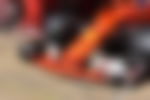

The two testing sessions are over and in a week’s time the cars will hit the track in Melbourne and the season will be underway. The regulation overhaul means that everyone has started from scratch (more or less) and the pecking order is unknown. While true performance levels of individual cars won’t be known until Australia, we can still dig a little bit into images and spec sheet to gauge and assesses the 2017 technical marvels. The top 3 team are the best and most intriguing of the lot. So let’s head out and take a look.
W08
ADVERTISEMENT
Article continues below this ad

Nose and front wing
At first glance there isn’t much new going on about the front wing except that it meets the required 12.5-degree back-sweep.

The nose, although similar to the 2016 car in stature, is another matter. Although the slender mounts have been outlawed for this year the camera pods remain in a similar position and sit upon almost identical vanes, only shorter. The S-duct is also a carry-over feature. Its design moves away from the simple exit slot utilised previously and instead follows what McLaren have been doing by embedding the car’s antenna in the middle and creating two deeper grooves.
Turning wanes
Perforated bodywork already looks like being a strong theme in 2017. It’s used to create elongated vortices that influence the surrounding freestream flow. The turning vanes that hang from beneath the nose are split into four elements, each with their own footplate that are again divided into a total of seven individual aerofoils.
BargeBoards
This area of the car is going to eat up a huge amount of development time as the regulations

A large, beautifully sculpted vane towers above the bargeboards. This also fits in the regulatory region described above – expect to see these sorts of devices break out as the season progresses.
Sidepods
As the power unit regulations mature the engineers find them easier to cool sufficiently, and so the inlets can be reduced in size and drag decreased.
Most of the cars will be around 15cm longer than last year to manage the larger front tyre wake and take advantage of the larger floor. The W08’s sidepods have certainly extended and as a result the coolers inside can also be stretched and the bodywork squeezed in for less blockage.

Together with intricate bargeboards there are equally complex flow conditioners which straddle the car. These are composed of three elements and reach forward to deflect as much wake from the sidepod undercut as possible. Their curled undersides entice clean flow towards the rear where it can be used more effectively.
These are accompanied by new wing mirrors which appear to incorporate infrared cameras to monitor tyre temperatures. The team’s partnership with Qualcomm has produced a variety of data acquisition and transferring techniques during their recent dominance and perhaps this is another development.
Whereas some of the other teams that have launched so far have taken the opportunity to narrow the frontal region of their sidepods, Mercedes has actually widened it, which is in keeping with the extra 100mm per side tolerance allowed by the new regulations.
However, whilst the sidepods have this extra girth, the sidepod’s inlet is perhaps the shallowest, allowing for an extreme undercut that tapers down the rest of the car into a very narrow coke bottle region, that is framed by an elevated cooling outlet, which begins in line with where we’d expect the engine and exhausts to sit.
In order to achieve this new-found slimness, the team has seemingly re-angled the radiators within the sidepods to facilitate the aerodynamic concept.
Floor and diffuser
Having finally got a proper glimpse of the 2017 diffusers it is clear that Mercedes have not held back in this area either. It complies with the rules yet already there are new ideas in view. Rather than a simple periphery flap the outboard sections have received, of all things, a bit of front wing treatment, featuring an extreme outsweep to further lure the air from underneath the car.

Having used scallop slots ahead of the rear tyres to displace turbulence away from the diffuser in recent years it is interesting to see Mercedes move to simple perforations for 2017 (albeit as many as nine of them).
Rear wing and mini-wing
The rear wing has a bow shaped profile – it is shallower at its tips than at the centre. This gives us some indication as to how aerodynamically balanced the car is, as the team doesn’t feel the need to go chasing maximum downforce at the expense of stability.
During the car’s second runs at Silverstone, while Valtteri Bottas was at the wheel, the W08 sprouted an additional narrow black wing between the rear wheels. This is within the box region of the shark fin so it would be legal. One possible use for this would be to control the wing tip vortices shed behind to reduce drag/back pressure. During the first pre season test Mercedes fitted a bi-plane version of its engine cover mounted winglet. It must be wondered how fast and far these designs will be allowed to developed before the FIA steps in.

SF70H

Ferrari tends to hide its race (and even test) specification parts at launch so any assessments of the front of the car should be taken with a pinch of salt.
The common thumb-tip nose remains and an S-duct has been integrated into the 2017 car.

At the moment the camera pods are fused with the nose with no mounting bodywork dictating the aerodynamics. Four overlapping fins – reminiscent of 2008 – sprout from the bulkhead to ease the transition of flow from the steep nose to the flat chassis top.
Bargeboards and Sidepods

The bargeboard area will be heavily exploited this year but Ferrari have kept their powder dry for the launch and testing.

The array of vanes and flow conditioners are designed to do a variety of things. The curled vane that stems from the sidepod shoulder forces the air down and along the undercut towards the back of the car. Closing off the top of the inlet is another horizontal vane that guides air into the aforementioned secondary intakes. Protruding into the front tyre wake is a huge rectangular board, shielding the undercut from turbulence. Two louvres are used to bleed off pressure built up on the inside face.

Shark Fin, Rear Wing and T-Wing

A shark fin and a T-wing – words you might not associate with F1 until now. The function of the shark fin is to ensure that airflow arrives cleanly at the lower rear-wing which now sits in a realm of dirty flow coming off the upstream bodywork.
The T-wing is a new feature for this year thanks to a small opening in the regulations as a result of the lower and slanted rear wing. It captures and kicks cleaner flow passing higher up the car upwards, enticing the flow coming off the rear-wing behind to rise. This helps the rear-wing to produce more downforce.
A monkey seat winglet has been installed on the rear crash structure but it is sat some distance from the exhaust exit. In recent years teams would use the combination of the hot exhaust gasses and a winglet to connect the diffuser and rear-wing aerostructures, generating an upwash effect. Given that the wing is lower and the diffuser now taller, a monkey seat is not as beneficiary.
RB13

Despite the overall simplicity of the new Red Bull, the front of the RB13 has had arguably the most treatment over winter than any of its main rivals.
Front Wing and Nose

There are no drastic changes to the front-wing but, unlike the rest of the grid, the upper flaps have an upturned shape inboard of the car.
The nose has drawn a lot of attention simply because nobody else has put a hole in their thumb tip extension. Lotus came up with a solution to evade the single cross section rule in 2014 and this has been copied inside the RB13’s nostril. A series of vertical aerofoil-shaped vanes are arranged in a vee and are arranged closely so that when any slice of the nose is taken, the upper part and lower parts of the channel are always connected by one of the vanes.
The hole exits immediately behind the tip and not up to the new S-duct or to the driver footwell, so it is clear that it has been designed to work the airflow passing over and around the neutral section of the front-wing.
Bargeboards and Bodywork

We all know how strong the Red Bull aero department are so whilst it was disappointing to see a lack of creativity in the bargeboard region we can be confident that something new is on its way ahead of Melbourne.
The bodywork along the mid-section of the car, however, is a joy to behold. Thanks to a much larger airbox, and subsidiary inlet behind the driver’s head, the sidepod intakes have been impressively downscaled. The bodywork then tapers beautifully towards the centre and slopes upwards to merge with the engine cover. The shrink-wrapping effect is so extreme

Having always put aero ahead of every other aspect of the car, the tight bodywork has many benefits – should the Renault power unit beneath be sufficiently cooled. The wider tyres and track width have had a notable impact on the car’s drag, meaning that power sensitivity is even higher from an engine perspective. To counter any potential shortfalls from Renault’s end, decreasing the car’s surface area will improve straightline speed. In addition, the exposed floor area as a result of this pinching effect can be used to power the rear diffuser, which is both taller and wider for 2017.
Floor and Rear Details
ADVERTISEMENT
Article continues below this ad
The wider floors have created room to play with their shape and how they influence flow along the car’s flanks. Unlike any of the other cars, sections of the floor have been removed beside the sidepod intakes to let low pressure air out along the side. Red Bull traditionally run a high rake angle to extract more performance from the diffuser. This requires good sealing of the floor and the cutouts will work in conjunction with the bargeboard devices to form an air skirt along the side of the car.

ADVERTISEMENT
Article continues below this ad
The larger rear diffuser continues with the edgeless outwash design with slots made into the sides to entice airflow out from beneath.
A simple but notable observation is the central exhaust placement, which now sits lower and between the two wastegate pipes. This lowers the car’s centre of gravity slightly and also opens up opportunities for a winglet to influence the exhaust plume.
ADVERTISEMENT
ADVERTISEMENT
ADVERTISEMENT
ADVERTISEMENT

